Are there square watermelons and how can you grow such an unusual crop yourself?
Unusual square-shaped watermelons immediately attract attention. Their first appearance caused surprise and a lot of emotions after the familiar round berries, but today they have ceased to be a curiosity and summer residents are even trying to grow such fruits on their plots.
What is a square watermelon: variety, mutation or secret of selection
Square watermelon is the result of the efforts of Japanese breeders. It appeared on domestic markets several years ago. This is not the only know-how that Eastern farmers have; they have learned to grow triangular-shaped berries, as well as in the form of pyramids, stars, hearts, and even give the fruits the appearance of fairy-tale characters.
Reference. When growing square watermelons, no modified components were used and no genetic experiments were carried out. These are absolutely healthy products that are grown using special devices that give them a certain geometric shape.
The photo shows a square watermelon.
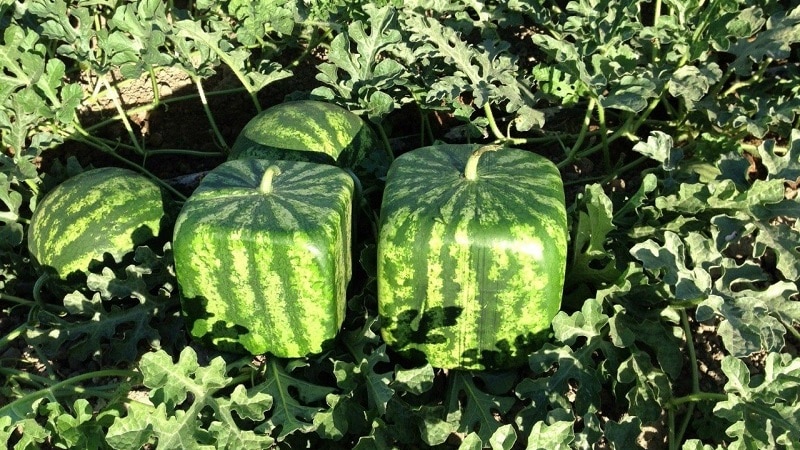
History of appearance
The invention is about 40 years old. Oktyabrina Ganichkina, Candidate of Agricultural Sciences, first spoke about the secret of farmers from Japan. She suggested that square berries are more convenient for transportation and storage, which she was partially right. Over time, breeders from other countries - Brazil, the United Arab Emirates, China, and Russia - became interested in fruits of this shape.
Experiments were first carried out in the city of Centxu in the 60s. It was there that farmers decided to place small young germs in containers, and they began to develop, taking the correct shape. The results of such efforts inspired experimenters, and soon not only square watermelons, but also tomatoes and melons were introduced to the world.
Who needed square watermelons and why?
It was necessary, first of all, for farmers who wanted to surprise consumers and draw attention to the product to change the traditional shape of the sugar berry. Initially, the price for one copy was several thousand rubles, which brought good profits to the industry.
Subsequently appreciated the benefits of the new growing technology and transport companies. The berries are compactly placed, which saves space and increases transportation volumes.
Ordinary buyers could not help but appreciate the efforts of the breeders. They were convinced that cutting and arranging portions of such watermelon is much easier and more convenient, and the dish looks original on the table.
How are they grown?
Achieve the expected result and grow Not only beautiful in appearance, but also a sweet berry is helped by compliance with certain conditions. Watermelons are suitable only for southern climatic regions where the weather remains consistently hot and dry.
Choose well-lit areas for planting - Shading is strictly contraindicated for the plant. Only non-acidic, fertile soil with added sand and lime is suitable.
Reference. Watermelons cannot be grown in areas where other melons or cabbage previously grew. Optimal predecessors are potatoes, peas, tomatoes and wheat.
At a certain stage of development, the young berry is enclosed in a rigid form, which securely fixes it on all sides.In this way, the specified geometric parameters are given. Enclosed in a cube, the fruit fills all available space as it grows.
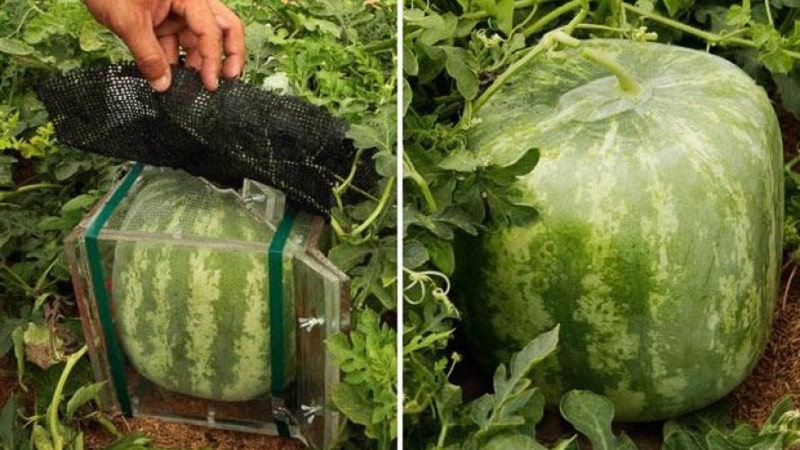
How to grow a square watermelon yourself
Growing a juicy and sweet square watermelon on your plot is not difficult if you take into account all the rules of agricultural technology.
The whole process consists of several successive stages:
- Seed preparation. The optimal time is the end of spring, so that the fruits have time to ripen. Pre-planting material is germinated in damp sand or moistened soil under bright light.
- Planting in open ground. The air temperature should not fall below +15°C.
- Formations. It begins when the crop reaches the size of a small apple.
Shoots appear from seeds after 10-12 days after placing them in an environment favorable for germination.
Read also:
How to make a mold
If you want to grow a square watermelon, you will have to stock up on the necessary set of tools. A suitable device for forming a square berry is made of polycarbonate, plastic or glass. The main thing is that it is a transparent and durable material that does not deform as the watermelons grow.
For making a mold:
- Cut the selected material into squares with a side of 20-25 cm.
- Fasten the blanks with screws to form a cube.
- Make a hole in one edge.
- Equip the lid with furniture swivel hinges.
- To make additional fasteners, use aluminum angles, securing them to the edges of the cube.
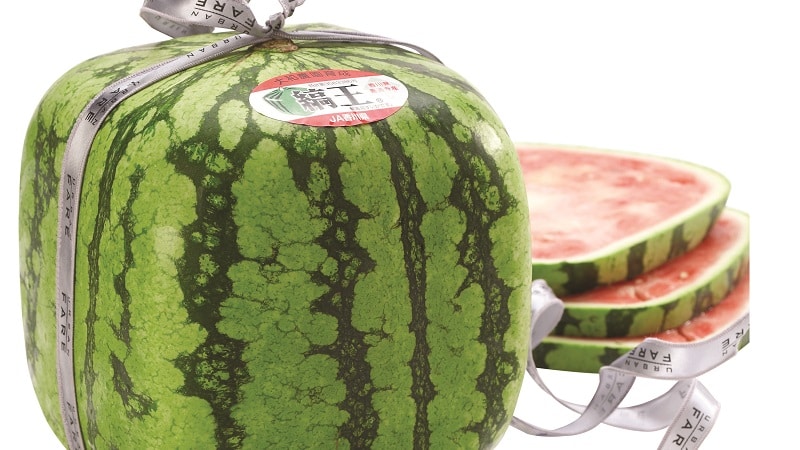
Planting a watermelon and proper care for it
When the temperature indicators reach the desired values (+15…+17°C), the sprouted seeds are sent to the site.If the spring has been cold and rainy, leave the young seedlings in peat pots until the soil warms up.
Reference. At low temperatures, planting is organized in greenhouses. Melons grow well in greenhouse conditions.
Sow at the rate of 10 seeds per 1 m². Not all of them will sprout, so this area is enough. The depth of the holes is from 6 to 8 cm. The first shoots will appear after 7-8 days.
Further care includes:
- gently loosening the soil when the 5th leaf appears;
- covering young seedlings in case of rainy weather;
- watering not into the hole itself, but onto the soil nearby.
Sufficient watering is the key to the formation of a juicy watermelon. Moisture must penetrate to a depth of more than 1 meter. This is exactly the length that the main root of a plant can reach.
Need for hydration depends on the stage of development:
- Before active formation of green mass begins, seedlings are watered 1-2 times a week.
- During the period of leaf growth, the soil is often moistened, but waterlogging is not allowed.
- When the fruits begin to ripen, stop watering. Otherwise, the berry will become watery and unsweetened.
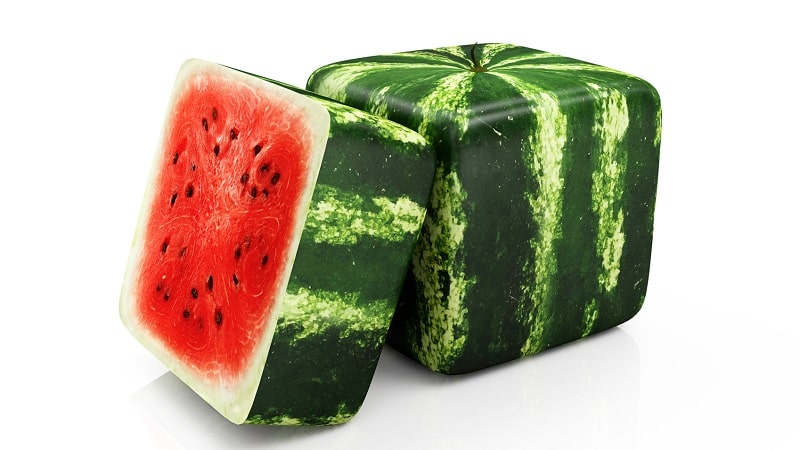
The optimal time for watering is evening. After moistening the soil, it is allowed fertilization. For this purpose, mineral complexes are used, which contain:
- magnesium;
- phosphorus;
- nitrogen;
- calcium;
- potassium.
At each stage of development, the culture perceives the application of fertilizing differently. Potassium ensures active and lush flowering and stimulates the formation of vitamin C, which accelerates ripening. It is applied a month after planting the seedlings in the ground. Nitrogen promotes the formation of a lush bush and activates the formation of ovaries. The plant needs it at the beginning of the growing season.
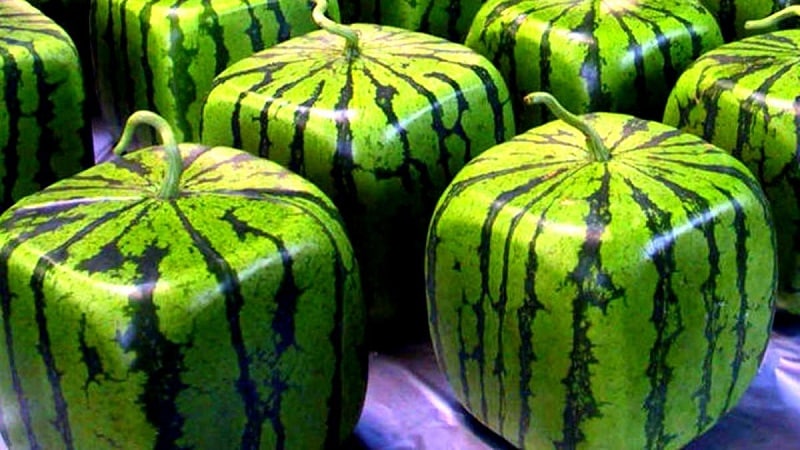
Used as fertilizer:
- Urea.Entered 3 times. The first is immediately after germination of the seedlings, then with an interval of 4.5 weeks.
- Complex mineral composition. With the appearance of the first buds - once every 2 weeks. 1 tsp. superphosphate and 1.5 tbsp. l. ammonium and potassium salts, diluted in 10 liters of water.
Compost made from leaves, grass, weed residues and vegetable crops is beneficial for the soil.. It is not recommended to add meat waste or fat to it, as the risk of slugs and parasites increases.
Manure and bird droppings are no less useful.. The components are diluted in a ratio of 2:10 with water and must be infused for 2-3 days, otherwise fresh fertilizer will burn the root part.
Important! Ammonium nitrate should not be used for fertilizing. It promotes the accumulation of dangerous nitrates in the pulp.
In regions where an arid climate prevails and the soils are deficient in nutrients, humus cannot be avoided. It is useful for watermelons during flowering and fruit development. It is enough to apply it every 3 weeks. Plants, paper and food waste are suitable for humus; The mixture must be heated for 2-3 years before use.
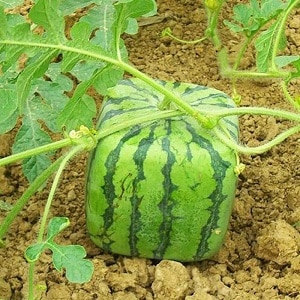 Wood ash is used as a means to prevent diseases and rot.. It is used to dust the soil or water it, after diluting it with water.
Wood ash is used as a means to prevent diseases and rot.. It is used to dust the soil or water it, after diluting it with water.
Feeding is applied in two ways:
- root - directly under the root of the plant;
- foliar - watering the deciduous part of the crop or spraying.
With proper care, watermelons begin to bloom in about 30-35 days. Then the fruits appear. When they reach 7-9 cm in diameter, the main lash is pinched and the side shoots are completely removed. So the plant will devote all its energy to the formation of the main ovary and berries.Weak specimens are removed from the site.
When is it time to use the form?
It’s time to fix watermelons that have reached 10 cm in diameter and place them in a prepared form.. Experienced gardeners know that if the container is smaller in size than the planned volume of fruit, the material will not hold up and will crack. If the shape turns out to be larger, it will not be possible to grow a cube-shaped product. The main thing in this matter is practice and experience.
Non-standard melons in shape have the same signs of maturity as round ones:
- dried stalk;
- shiny, almost glossy peel that does not sag when pressed with your fingers;
- light ground part of the fruit.
Checking the ripeness of watermelons by the characteristic ringing sound is a myth. Such berries are considered overripe.
Where to buy a square watermelon
Initially, the cultivation of square berries was carried out only in Japan, therefore, such goods were found only on local agricultural lands and by pre-order. Now domestic farmers have learned to annually grow such a quantity of unusual watermelons that will satisfy the demands of the entire Russian market.
Square fruits appear on supermarket shelves even in the dead of winter. The opportunity to enjoy juicy and sweet pulp is given to consumers by owners of greenhouses from foreign countries, where climatic conditions are favorable for harvesting almost all year round.
Storage Features
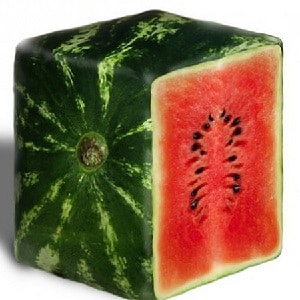 The approximate period from the moment of planting seeds to harvesting is about 100 days. Do this in a timely manner, otherwise the watermelons will not be stored for long. Use sharp knives or pruning shears for cutting. The length of the remaining tail is at least 5 cm.
The approximate period from the moment of planting seeds to harvesting is about 100 days. Do this in a timely manner, otherwise the watermelons will not be stored for long. Use sharp knives or pruning shears for cutting. The length of the remaining tail is at least 5 cm.
Only whole berries are suitable for storage, without damage.. They are placed on a straw bed in a dark room.The berries are also placed in dry earthen trenches, each layer sprinkled with shavings or straw, on wooden shelves.
The harvest is stored well in well-ventilated and dry rooms. in the form of pyramids of 8-9 rows. To prevent damage to the fragile product, the placement area is fenced with boards.
Advantages and disadvantages of a square watermelon
Unusual berries have no differences in taste from their round counterparts. They are just as juicy and sweet, but they also have a number of other advantages.:
- allow you to optimize transportation costs;
- practical for placement and storage, do not move or fall;
- Convenient to cut and serve.
The main disadvantage of the new product is the risk of uneven ripening. Therefore, some berries are inferior in taste to rounded specimens.
Due to their original shape and aesthetic appeal, square watermelons are more expensive. This is the main factor that prevents large-scale cultivation of unusual melons from starting.
Conclusion
Original cube-shaped watermelons are pleasing to the eye. This is not a product of genetic modification, but an amazing result of simple actions of breeders. Even an ordinary gardener can grow such a berry. The main thing is that the climatic conditions are suitable for the ripening of melons.